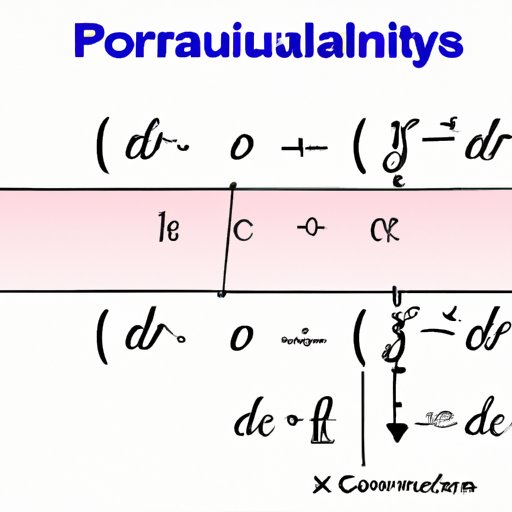
Introduction
Constant of proportionality is a fundamental concept used in linear functions to calculate the relationship between two variables. Whether you’re calculating slope or trying to find the straight-line equation of a given set of data, understanding how to determine the constant of proportionality is essential. This article aims to provide a complete guide to finding the constant of proportionality in a linear function. You’ll learn what it is, why it’s crucial, and more importantly, how to calculate it with ease.
A Step-by-Step Guide for Finding the Constant of Proportionality in a Linear Function
Before we dive into how to find the constant of proportionality, we need to understand what linear functions and constant of proportionality are. A linear function is a mathematical equation where the line has a constant slope. The constant of proportionality, also known as proportionality constant, is the ratio between two variables that are directly proportional. In other words, the ratio between the change in one variable and the corresponding change in the other variable is a constant value.
To find the constant of proportionality in a linear function, you need to follow these steps:
- Identify the two variables in the equation. Usually, one variable is dependent and the other is independent.
- Choose a data point from the given data set.
- Identify the change in the dependent variable for the given data point.
- Identify the change in the independent variable for the given data point.
- Divide the change in the dependent variable by the change in the independent variable to get the constant of proportionality.
Let’s take a look at a sample problem. Suppose you’re given the following data pairs:
| Dependent Variable (y) | Independent Variable (x) |
|---|---|
| 5 | 3 |
| 10 | 6 |
| 15 | 9 |
To find the constant of proportionality, we follow the steps mentioned above:
- The two variables in the equation are y and x.
- Let’s choose the data point (5,3).
- The change in the dependent variable for this data point is 5 – 0 = 5
- The change in the independent variable for this data point is 3 – 0 = 3
- The constant of proportionality is 5/3 = 1.67
Understanding the Importance of the Constant of Proportionality in Real-World Scenarios
The constant of proportionality is an essential concept in various fields, including economics, physics, and engineering. Economists use it to calculate the relationship between supply and demand, while engineers use it to design machines and structures to withstand varying amounts of pressure and stress.
For example, in the world of physics, the constant of proportionality is used to calculate the relationship between force and acceleration. The proportionality constant between force and acceleration is known as mass, as represented by the equation F = ma. In economics, the constant of proportionality is used to understand the relationship between price and demand. The more the price goes up, the less demand there is for a particular product, and vice versa.
Common Mistakes to Avoid When Finding the Constant of Proportionality
While finding the constant of proportionality is a relatively simple process, there are some common errors and missteps that people tend to make. Here are some things to watch out for:
- Make sure you’re dividing the change in the dependent variable by the change in the independent variable. It’s not the other way around.
- Avoid mistaking the constant of proportionality for the slope of the line.
- Double-check your calculations to ensure that there are no mathematical errors.
Alternative Methods for Finding the Constant of Proportionality
While the step-by-step process mentioned earlier is the most common way to calculate the constant of proportionality, there are other methods available as well. Let’s take a look at some of the alternative approaches:
Graphing
One way to identify the constant of proportionality is by graphing the data and looking for a straight-line relationship. The constant of proportionality is the slope of the line. By plotting the data points and drawing a line through them, you can quickly identify the constant of proportionality.
Algebraic Calculations
You can also use algebraic equations to solve for the constant of proportionality. For example, you can rearrange the formula for a linear function to solve for k, the constant of proportionality. The equation would look like y = kx, where k is the constant of proportionality.
Estimation
Another way to find the constant of proportionality is through estimation. While this method is less accurate than the others, it can be useful when you don’t have access to complete data. With estimation, you can make an educated guess about the value of the constant of proportionality based on your knowledge of the variables involved.
Mastering the Concept of Constant of Proportionality Through Practice Problems
Now that you know how to find the constant of proportionality let’s practice with some sample problems. Try solving these on your own before looking at the answers:
- An athlete runs 10 miles in 2 hours. Find the constant of proportionality.
- If 6 apples cost $1.50, how much would 10 apples cost?
Answers :
- 5 miles per hour, because the athlete runs 5 miles in one hour.
- $2.50, because the cost of one apple is $0.25.
Conclusion
The concept of constant of proportionality is a vital component of linear functions. Not only is it essential in mathematics, but it’s also used in real-world scenarios in various fields. By following the steps mentioned above, you can find the constant of proportionality in a given set of data with ease. Avoiding common mistakes and exploring alternative methods can help you master the concept more efficiently. By practicing with problems and applying the ideas you’ve learned, you’ll be able to use the constant of proportionality for your calculations in no time.




